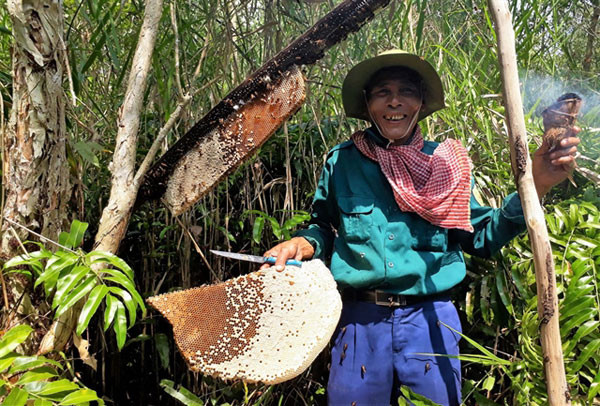
Nature has endowed Vietnam's southernmost province of Ca Mau with a vast cajeput forest, home to thousands of honeybee colonies. The province is also the birthplace of a unique craft – gác kèo ong (literally, luring bees to build nests on sloping wooden poles).
Recognised as a national intangible cultural heritage in 2020, the craft in Ca Mau has created momentum for locals to develop a sustainable business, eco-tourism and protect forests.
Unique work
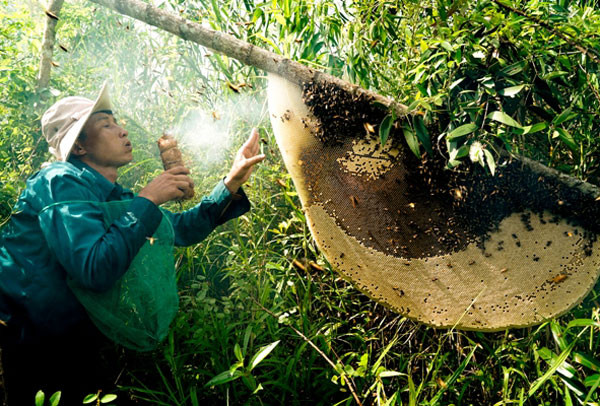
Locals say gác kèo ong, which is passed on between generations, has been practised in U Minh and Tran Van Thoi districts since the latter half of the 19th century when people began developing the areas.
According to Pham Duy Khanh, a senior local beekeeper and owner of an eco-tourism site, every year, particularly from August or September, when cajeput trees are in full bloom and give off their unique scent, luring swarms of honeybees to come to collect pollen and look for a place to live on a sloping branch nearby.
Observing the honeybees' living habits, local men erected a kind of 'sloping branches' among cajeput trees to lure honeybees to settle on and build their nests. Then the 'bee hunters' just wait to harvest the honey.
The 'artificial branch' is often a small cajeput tree trunk, about 10cm-15cm in diameter and two to three metres in length. A layer of wax is applied to the branch to lure the bees.
Bee hunters use their experience to consider wind direction, sunlight, and the flight paths of the honeybees when deciding the ideal location for erecting their branches.
The 'artificial branch' should be hung at an incline of 45 degrees to ensure sunlight reaches them. Most importantly it must be erected close to some cajeput trees in full bloom. It often takes between 20 and 30 days for the bees to build their home on the branch.
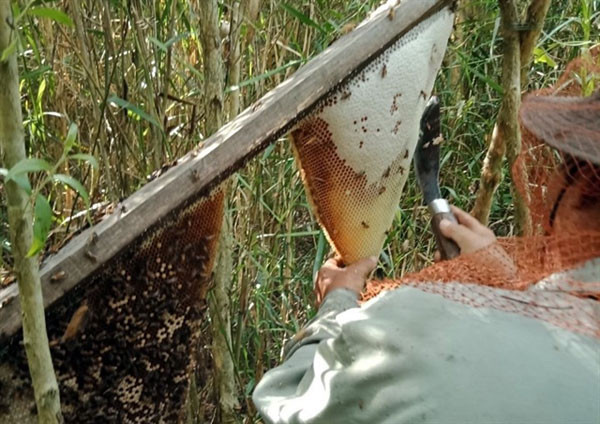
Bee hunters keep a close eye on their 'installation work' or "the house for the bees" as they call it, to predict when the bees will come to build the nest and how long it will take for the bees to produce enough honey to be harvested.
The best time to erect the 'sloping branch' is between sunrise and 9am, while the best time to harvest is from 6am to 8am.
“The amount of honey depends on the position of the 'sloping branch' installed. In the dry season, some bee nests can contain from 2 to 10 litres of natural honey, and in the rainy season they can only have over a litre depending on the size of the nest,” Khanh said.
The bee hunters need many tools, the most indispensable being kindling made from coconut fibre or dried coconut roots and a protective face net to prevent bee stings. Some experienced hunters even choose not to use the latter.
Before collecting the honey, the hunters place smoking kindling close to the nests, which forces the bees to fly away. After the honey has been collected, it is necessary to leave a piece of honeycomb behind so that the bees would return to rebuild their nests.
“It is normal for us to be stung by the bees,” said Tran Van Chon. “However, we mustn’t kill any bee on being stung. Otherwise, we will be attacked by the whole swarm, which is the first lesson for any beginner. Many hunters consider the forest their home and bees as pets, so we never kill them.”
After harvest, the best way to keep the honey is to pour it into ceramic containers or dark glass bottles.
From heritage to tourism product
For many years, the hunting of honeybees in the wild in U Minh Ha National Park has brought significant income to locals.
Each bee nest can produce about 4-5 litres of honey, which can be sold at around VND250,000 (US$11) per litre.
Said to offer the best quality and have a distinctive flavour, U Minh Ha honey has become a famous speciality of Ca Mau. In 2011, the National Office of Intellectual Property credited U Minh Ha honey products as a collective brand.
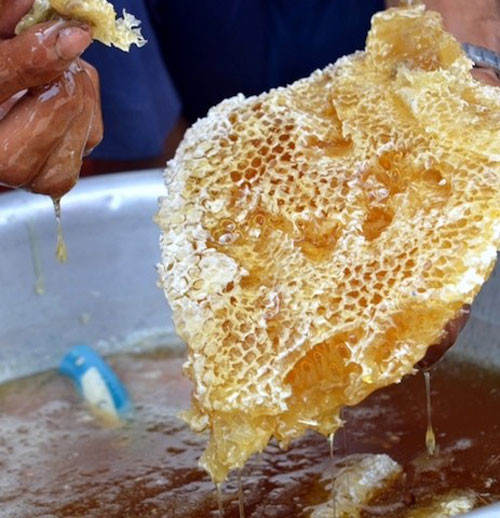
The specialty of the province became more widely known when the 'honeybee-luring craft' of U Minh and Tran Van Thoi districts was recognised as a National Intangible Cultural Heritage in 2020.
“The recognition has created more motivation for local bee hunters to pursue their craft and contributed to local economic development, forest protection and poverty reduction,” said Tran Hieu Hung, director of the Department of Culture, Sports and Tourism of Ca Mau.
A team of local bee hunters was established in the region in 1984 to share information and experience. It has become a cooperative, operating in a cajeput forest area of 520ha.
As cajeput forests are part of the Ca Mau Cape Reserve Area, cooperative members are offered technical training and protective equipment to collect honey and prevent forest fires.
The natural honey collecting practice in the region has also been turned into an eco-tourism product for visitors to experience honey collecting and taste the specialty.
A popular destination in the region where visitors can play bee hunters for the day is the Muoi Ngot eco-tourism site, which covers over 40ha of forest and offers a home to hundreds of bee nests.
According to its owner, Pham Duy Khanh, the traditional craft of Ca Mau has been identified as one of the major attractions to the area since its establishment in 2015.
Visitors to this eco-tourism site can spend a day in the forest with local bee hunters, witnessing them perform every stage, from erecting the 'sloping branches' to luring bees or harvesting the honey.
“I used to watch the scene of honey collection on TV, but the trip to the site enabled me to do it myself. I felt both scared and excited,” said Ho Thu Hang, a tourist from the central province of Nghe An.
Recently, the largest bee nest in Vietnam was discovered in the Muoi Ngot eco-tourism site and set a national record. Weighing 43kg, it is expected to contain about 15 litres of honey. The nest is on display at the U Minh Forest space for visitors who want to explore the local culture.
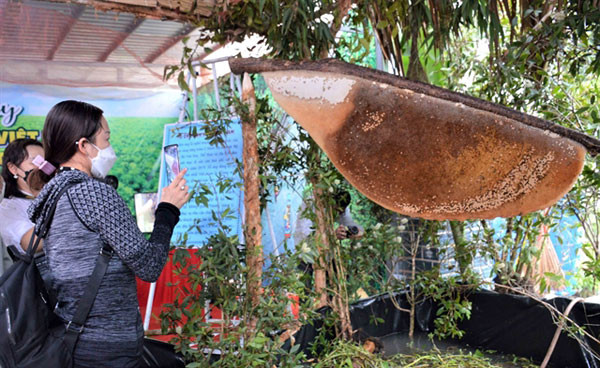
Khanh said that as long as the specialties of the cajeput forest could increase economic efficiency thanks to tourism, local people would be more aware of forest protection and continue to pursue the craft of their ancestors.
Source: Vietnam News